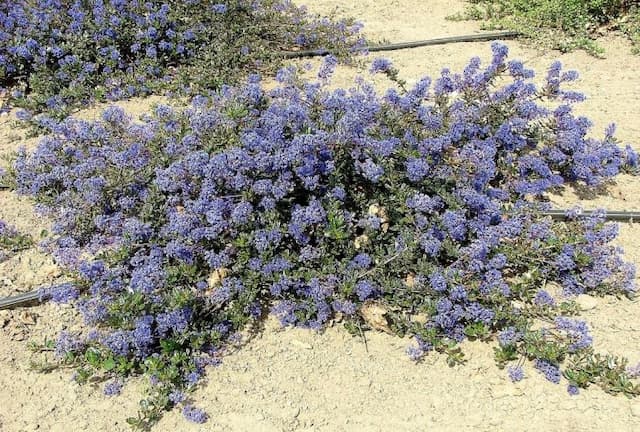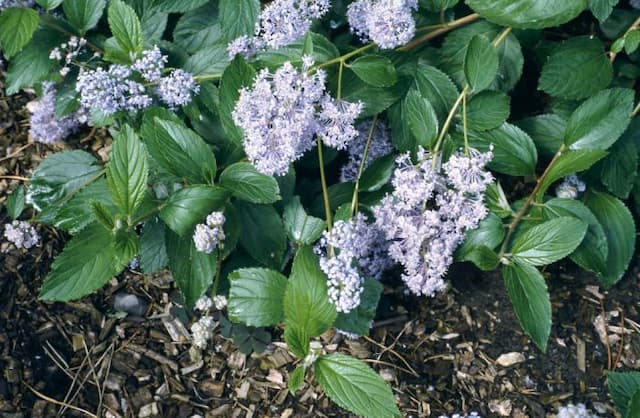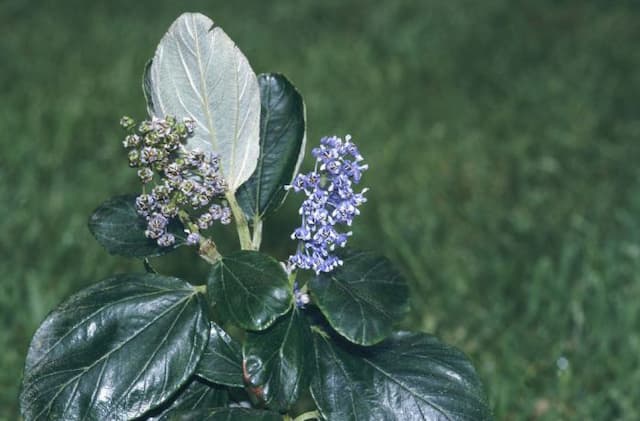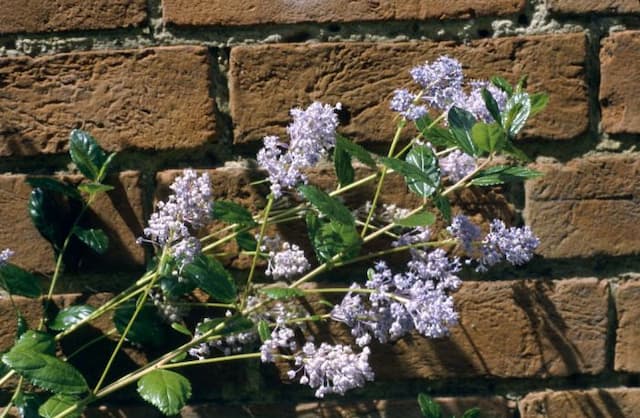California Lilac Ceanothus thyrsiflorus

ABOUT
The plant commonly known as California lilac is an evergreen shrub that has a rounded and bushy appearance. Its foliage comprises glossy, dark green leaves that contrast beautifully with the profuse clusters of blue flowers that adorn it. The leaves are small, oval in shape, and range from being slightly serrated to completely smooth on the edges. When the plant blooms, it produces an abundance of tiny, yet showy blue flowers that are grouped tightly in cone-shaped clusters, which arrive in spring and sometimes last into early summer. These flowers are a magnet for a variety of pollinators, including bees and butterflies, contributing to its ornamental value. The California lilac's bark is another distinctive feature; it is reddish-brown and peels in thin strips, adding to the plant’s overall visual interest. As a versatile ornamental, it is commonly used in landscaping to create hedges, screens, or as a stand-alone focal point in a garden due to its dense and lush appearance.
About this plant
 Names
NamesFamily
Rhamnaceae
Synonyms
Blue Blossom, Blue Bush, California Lilac, Coast Ceanothus
Common names
Ceanothus caeruleus, Ceanothus velutinus var. hookeri, Ceanothus thyrsiflorus var. griseus, Ceanothus thyrsiflorus var. repens.
 Characteristics
CharacteristicsLife cycle
Perennials
Foliage type
Evergreen
Color of leaves
Green
Flower color
Blue
Height
6-9 feet (1.8-2.7 meters)
Spread
6-9 feet (1.8-2.7 meters)
Plant type
Shrub
Hardiness zones
7-10
Native area
California
Benefits
 General Benefits
General Benefits- Attracts Pollinators: Ceanothus thyrsiflorus, commonly known as California lilac, is popular for attracting bees and other pollinators, which is beneficial for the health of the local ecosystem and for garden pollination.
- Drought Tolerance: Once established, California lilac is highly drought-tolerant, making it an excellent choice for water-wise gardens and landscapes in arid climates.
- Low Maintenance: It requires minimal care once it has taken root, reducing the need for constant gardening attention.
- Erosion Control: The plant has a strong root system that helps to stabilize slopes and prevent soil erosion.
- Habitat Support: Provides food and shelter for various species of wildlife, including birds and beneficial insects.
- Decorative Landscaping: With its showy blue or purple flowers, California lilac is used for decorative purposes in landscape design, adding a pop of color to gardens.
- Native Planting: As a native plant to California, incorporating Ceanothus thyrsiflorus into landscapes supports local biodiversity and is often easier to grow than non-native species.
 Medical Properties
Medical Properties- This plant is not used for medical purposes.
 Air-purifying Qualities
Air-purifying QualitiesThis plant is not specifically known for air purifying qualities.
 Other Uses
Other Uses- Dye Production: The flowers of the California lilac can be used to produce a green dye, which can color textiles and other materials.
- Garden Bonsai: California lilac can be trained as a bonsai for ornamental purposes, showcasing the plant's miniature blooms and dense foliage.
- Erosion Control: Its extensive root system helps stabilize slopes and banks, making it suitable for erosion control in landscaping projects.
- Hedge or Privacy Screen: California lilac can be pruned and shaped into a dense hedge, serving as a privacy screen or windbreak in gardens.
- Xeriscaping: Due to its drought tolerance, it's useful in xeriscapes, landscapes that reduce or eliminate the need for supplemental water from irrigation.
- Habitat Restoration: California lilac is used in habitat restoration projects, especially in its native range, to support local ecosystems.
- Wildlife Attraction: Its blooms attract pollinators like bees and butterflies, while its seeds provide food for local bird species.
- Perfumery: Some species of Ceanothus, including California lilac, can be utilized for their fragrance in the production of natural perfumes.
- Photographic Subject: The striking blue flowers of the California lilac make it a popular subject for nature and garden photographers.
- Culinary Garnish: Although not widely recognized as an edible, the flowers can occasionally be used as a decorative, non-toxic garnish for salads and desserts.
Interesting Facts
 Feng Shui
Feng ShuiThe California lilac is not used in Feng Shui practice.
 Zodiac Sign Compitability
Zodiac Sign CompitabilityThe California lilac is not used in astrology practice.
 Plant Symbolism
Plant Symbolism- Resilience: Ceanothus thyrsiflorus, commonly known as the California Lilac, thrives in harsh conditions with poor soil and minimal water, symbolizing the ability to endure and prosper despite difficulties.
- Hardiness: This plant is known for its vigorous nature and ability to withstand cold climates, representing robustness and strength.
- Purity: The California Lilac's bright blue flowers are often associated with purity and cleanliness, akin to the clear blue sky.
- New Beginnings: Because the California Lilac is one of the first plants to bloom in the spring season, it symbolizes new beginnings and fresh starts.
- Reward for Patience: The plant takes time to establish but rewards the gardener with stunning blooms, symbolizing that patience can lead to beautiful outcomes.
- Inspiration: The vibrant color and fragrant blossoms of the California Lilac are often thought to inspire creativity and uplift the spirit.
 Water
WaterFor California lilac, also known as Ceanothus thyrsiflorus, it is crucial to establish a deep-rooted system early on by watering deeply. Once established, these shrubs are quite drought tolerant. During the first growing season, water the plant once a week with approximately 1-2 gallons, ensuring that the soil is moist but not waterlogged. After establishment, you can reduce watering to every 2-3 weeks, depending on the climate and soil conditions, with a similar amount of water. If you are in an area with dry summers, occasional deep watering during this period can help the plant thrive.
 Light
LightCalifornia lilac thrives in full sun to partial shade. It is best to plant it in a location where it can receive at least six hours of direct sunlight daily. Areas with morning sun and afternoon shade are ideal to protect the foliage from intense heat. Ensure the plant has ample light exposure for optimal growth and flower production.
 Temperature
TemperatureCalifornia lilac performs well in a range of temperatures, from coastal to inland climates. It can survive minimum temperatures down to around 10-15 degrees Fahrenheit. The plant prefers a mild climate with ideal temperatures ranging between 50-75 degrees Fahrenheit. Extreme heat above 95 degrees Fahrenheit can be stressful for the plant, so if you live in a hot climate, provide some afternoon shade to prevent overheating.
 Pruning
PruningPrune the California lilac to shape the plant, remove dead or damaged branches, and promote a more compact growth habit. Pruning is best done after the plant has finished flowering in late spring or early summer. Cut back the flowered stems by one-third to encourage new growth and a second bloom. Regular pruning is not strictly necessary, but can be beneficial for maintaining an attractive shape and preventing the plant from becoming too leggy.
 Cleaning
CleaningNot needed
 Soil
SoilCalifornia Lilac thrives best in well-drained soil with low to moderate fertility; it prefers a slightly acidic to neutral pH, ranging from 5.5 to 7.5. A good soil mix can be made with equal parts of garden soil, coarse sand, and peat or compost to enhance drainage and provide aeration. Avoid heavy, wet soils and over-fertilization, which can harm the plant.
 Repotting
RepottingCalifornia Lilac is typically an outdoor shrub and, once established in the garden, does not require repotting. In containers, young plants may be repotted every two to three years to refresh the soil and provide space for growth.
 Humidity & Misting
Humidity & MistingCalifornia Lilac prefers moderate humidity levels but is quite adaptable and can tolerate the drier conditions typical of its Mediterranean and coastal California native habitat.
 Suitable locations
Suitable locationsIndoor
Bright light, light watering, well-drained soil.
Outdoor
Full sun, well-drained soil, low water.
Hardiness zone
7-10 USDA.
 Life cycle
Life cycleCeanothus thyrsiflorus, commonly known as California lilac, begins its life cycle when seeds, which are extremely hard and fire-resistant, germinate, often after a wildfire or with scarification to break dormancy. Seedlings establish a deep root system and the plant enters a rapid vegetative growth phase, forming a woody shrub with dark green leaves. After 2-3 years, California lilac reaches maturity and begins to produce clusters of small, blue or lavender flowers in the spring, attracting pollinators such as bees and butterflies. Once pollinated, the flowers develop into small, hard fruits that eventually dry and expel seeds, continuing the reproductive cycle. Throughout its life, which can last for several decades, California lilac can withstand drought by dropping leaves in severe conditions and resprouting when the environment is favorable. The plant's life cycle concludes when it succumbs to old age, disease, or environmental stressors, leaving behind seeds that can remain viable in the soil for many years, awaiting the right conditions to germinate.
 Propogation
PropogationPropogation time
Spring
The most popular method of propagating California lilac (Ceanothus thyrsiflorus) is through semi-hardwood cuttings. This is typically done in late summer. Cuttings should be taken from new growth that has begun to harden but is not yet fully woody, usually about 4 to 6 inches in length (approximately 10 to 15 centimeters). The bottom end of the cutting should be dipped in rooting hormone before being planted in a moist potting mix. The pot should then be covered with plastic to maintain high humidity and placed in indirect light. Roots usually form within a few weeks, after which the plastic can be gradually removed and the plant can be moved to a larger pot or directly into the garden.









